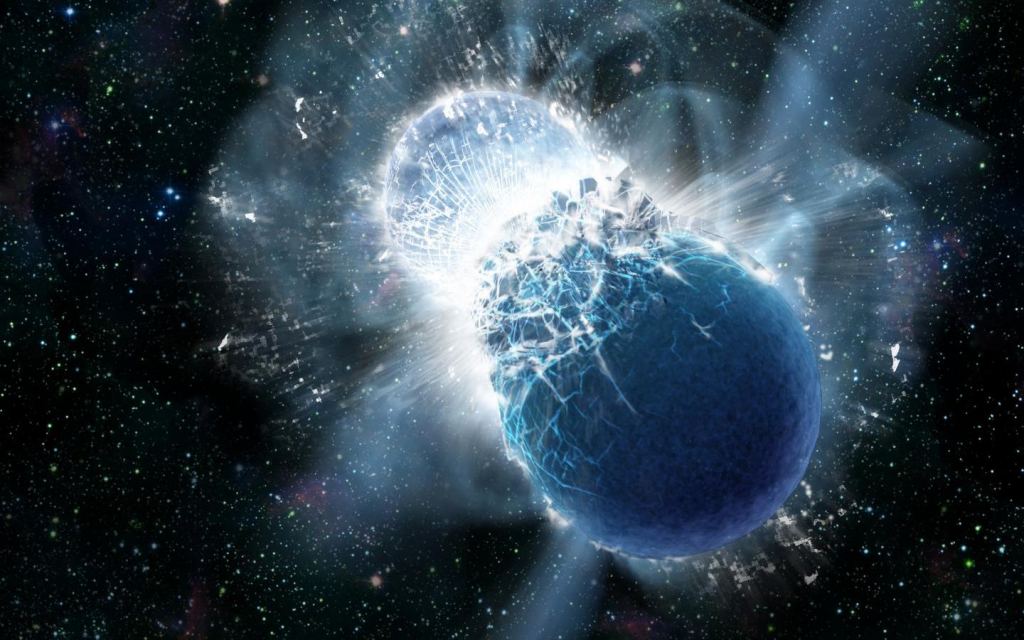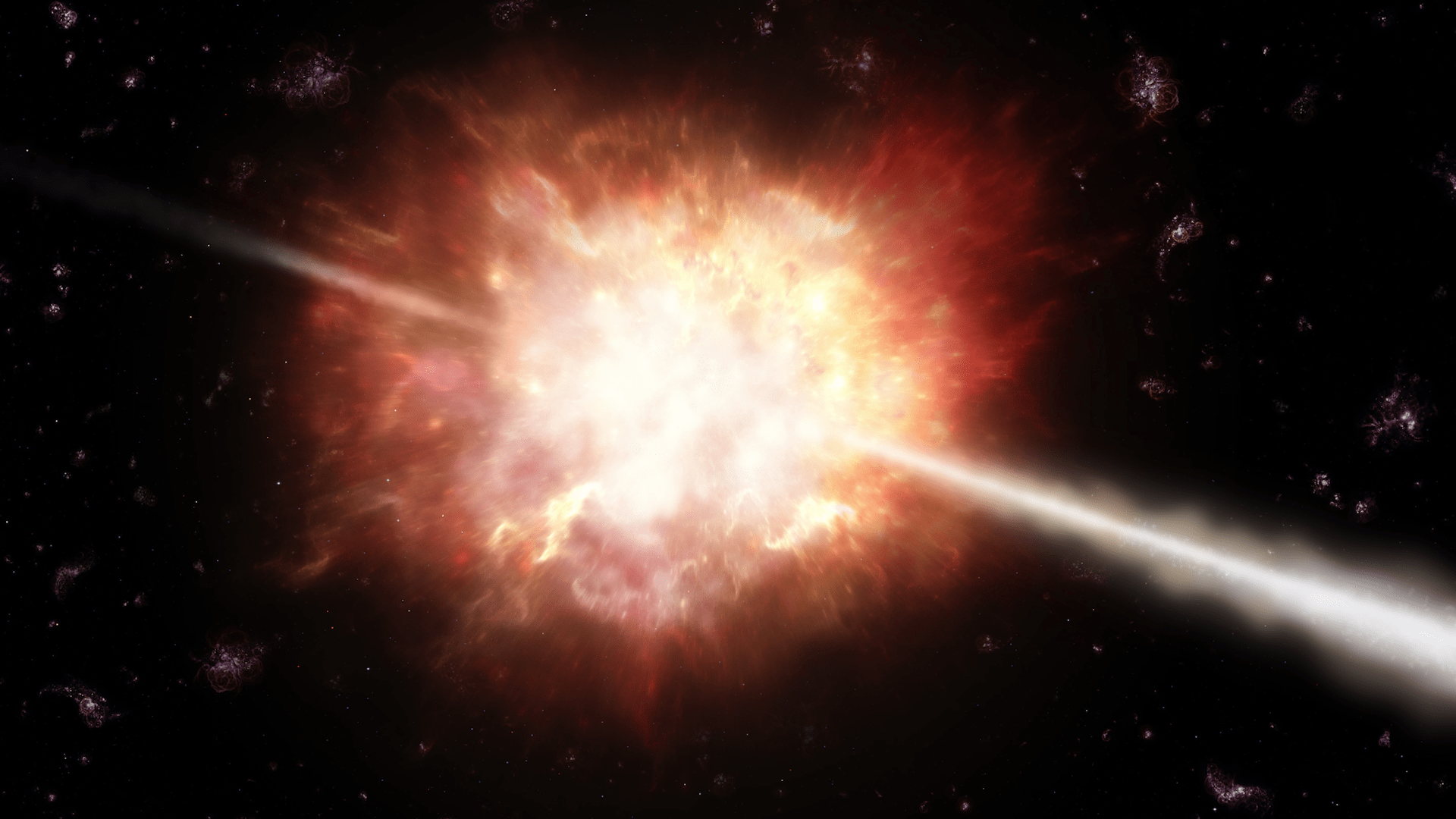Gamma-ray bursts (GRBs) are one of the most mysterious transient phenomena facing astronomers today. These incredibly energetic bursts are the most powerful electromagnetic events observed since the Big Bang and can last from a few milliseconds to many hours. Whereas longer bursts are thought to occur during supernovae, when massive stars undergo gravitational collapse and shed their outer layer to become black holes, shorter events have also been recorded when massive binary objects (black holes and neutron stars) merge.
These bursts are characterized by an initial flash of gamma rays and a longer-lived “afterglow” typically emitted in X-ray, ultraviolet, radio, and other longer wavelengths. In the early-morning hours on October 14th, 2022, two independent teams of astronomers using the Gemini South telescope observed the aftermath of a GRB designated GRB221009A. Located 2.4 billion light-years away in the Sagitta constellation, this event was perhaps the closes and most powerful explosion ever recorded and was likely triggered by a supernova that gave birth to a black hole.
Longer-duration GRBs occur when massive stars go supernova, producing a remnant black hole and blowing off their outer layers. The force of this explosion creates powerful jets as ejected material is accelerated to nearly the speed of light, pushing through debris and emitting X-rays and gamma-rays as they reach further into space. If these jets travel in the general direction of Earth, astronomers will observe them as bright flashes of X-rays and gamma-rays. Using data from some of the most powerful telescopes on Earth and in space, astronomers were able to make unprecedented observations of a nearby GRB.
GRB221009A was first detected on the morning of October 9th, 2022, by X-ray and gamma-ray space telescopes – including NASA’s Fermi Gamma-ray Space Telescope, Neil Gehrels Swift Observatory, and the Wind spacecraft. Almost immediately after, observatories worldwide raced to conduct follow-up observations and determine what resulted. Using the Gemini South telescope (operated by NOIRLab), two independent teams made rapid Target of Opportunity (ToO) observations of the powerful event’s afterglow.
The teams were led by Brendan O’Connor, a graduate observational astronomer with the University of Maryland and George Washington University, and Jillian Rastinejad, a Ph.D. student at Northwestern University’s Center for Interdisciplinary Exploration and Research in Astrophysics (CIERA). The two teams obtained the earliest-possible observations of the afterglow mere minutes apart using the Gemini South’s FLAMINGOS-2 near-infrared imaging instrument and the Gemini Multi-Object Spectrograph (GMOS), respectively.
As Rastinejad explained in a recent NOIRLab’s press release, their combined datasets produced an image of what could be the brightest GRB ever observed:
“In our research group, we’ve been referring to this burst as the ‘BOAT,’ or Brightest Of All Time, because when you look at the thousands of bursts gamma-ray telescopes have been detecting since the 1990s, this one stands apart. Gemini’s sensitivity and diverse instrument suite will help us to observe GRB221009A’s optical counterparts to much later times than most ground-based telescopes can observe. This will help us understand what made this gamma-ray burst so uniquely bright and energetic.“
The speed with which the teams made their observations is a testament to the Gemini Observatory’s infrastructure and data-reduction software – including the Fast Initial Reduction Engine (FIRE) and Data Reduction for Astronomy from Gemini Observatory North and South (DRAGONS) platforms. Shortly after, the NASA Gamma-ray Coordinates Network began filling up with reports from observatories worldwide. Based on the available data, scientists believe that the GRB was the result of a collapse of a star many times the mass of our Sun that gave birth to a black hole.

What’s more, the data from this event may help resolve an ongoing mystery regarding GRBs. Whereas most gamma-ray bursts have been observed in distant galaxies, some appear as lonely flashes from intergalactic space. This has raised questions about the true origins and distances of GRBs, with many astronomers theorizing that certain short bursts originate in the intergalactic medium (IGM). However, these results suggest that short GRBs may have been more common in the past than expected.
The research teams came to this conclusion after consulting data on the 120 short GRBs observed by the two main instruments aboard NASA’s Neil Gehrels Swift Observatory – the Burst Alert Telescope (BAT) and the Swift X-ray Telescope, which detect bursts and examine the X-ray afterglow. They paired this with additional afterglow studies made with the Lowell Discovery Telescope (LDT), which found that 43 of the short GRBs were not associated with any known galaxy and appeared in the comparatively empty space between galaxies. As O’Connor explained in a University of Maryland news story:
“Many short GRBs are found in bright galaxies relatively close to us, but some of them appear to have no corresponding galactic home. By pinpointing where the short GRBs originate, we were able to comb through troves of data from observatories like the twin Gemini telescopes to find the faint glow of galaxies that were simply too distant to be recognized before.”
These findings could also have implications for our understanding of the early Universe. In recent years, astronomers have found evidence that precious metals like gold and platinum may have come from neutron star mergers that happened billions of years ago. If these events were more common in the past, it could mean that the Universe was seeded with precious metals earlier than expected. In the meantime, the energetic nature of this event makes it a once-in-a-lifetime opportunity for astronomers. As O’Conner explained:
“The exceptionally long GRB 221009A is the brightest GRB ever recorded and its afterglow is smashing all records at all wavelengths. Because this burst is so bright and also nearby, we think this is a once-in-a-century opportunity to address some of the most fundamental questions regarding these explosions, from the formation of black holes to tests of dark matter models.”

Because of its relative proximity to Earth, this event is also a unique opportunity to study the origin of the elements heavier than iron (which form in the interiors of stars) and whether they come from neutron-star mergers alone or collapsing stars as well. Last, but not least, this event also led to disturbances in the Earth’s ionosphere that affected long-wave radio transmissions and produced very high-energy (18 tera-electron-volt) photons detected by the Chinese Large High Altitude Air Shower Observatory.
How these photons survived the 2.4 billion-year journey to Earth is a mystery. Therefore, this data could reveal new insight into how the laws of physics behave in extreme circumstances and allow astrophysics to predict the effect that future GRBs could have on Earth.
The International Gemini Observatory consists of the Gemini North Telescope in Hawaii and the Gemini South Telescope in Chile, which are operated by the National Optical-Infrared Astronomy Research Laboratory (NOIRLab) – part of the National Science Foundation’s (NSF). The papers that describe the two teams’ findings recently appeared in the Monthly Notices of the Royal Astronomical Society and The Astrophysical Journal.


Quoting artice:
Located 2.4 billion light-years away in the Sagitta constellation, this event was perhaps the closes and most powerful explosion ever recorded
I am confused – Isn’t SN1987A the first Supernova explosion recorded being located in the LMC at 168,000 light years distant. Neutrinos were recorded before the event so it seems this would be the first and closest SN explosion recorded…